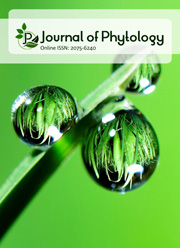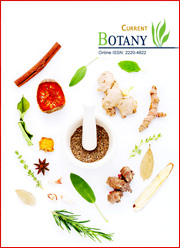Cytotoxicity effect and antioxidant potential of 5-Hydroxymethyl Furfural (5-HMF) analogues-An advance approach
DOI:
https://doi.org/10.25081/jp.2024.v16.8817Keywords:
Rivea hypocrateriformis, 5-HMF (5-hydroxymethyl-2-furfural), Quinoline, Antioxidant, AnticancerAbstract
Rivea hypocrateriformis (Desr.) Choisy is a profound medicinal belongs to the family Convolvulaceae. Natural products are considered as an alternative source for a positive approach to the drug design and drug discovery. R. hypocrateriformis is becoming the most important natural source to produce diverse phytometabolites with varying biochemical activities. Therefore, in the proposed study, we utilizing R. hypocrateriformis for isolating the 5-hydroxymethyl-2-furfural (5-HMF) and characterized it by different scientifically approved spectroscopic techniques namely 1HNMR, 13C NMR, FTIR and mass spectroscopy respectively. As a part of this study, the synthesis of chemical analogues has been achieved by coupling 5-HMF with quinoline derivatives and it was also studied for their antioxidant and anticancer potentials. The results demonstrated that amongst the test compounds, 3d and 3b have shown significant free radical scavenging assay followed by 3e and 3a with a maximum inhibitory effect, 76.69 %, 75.90 %, 67.60 % and 56.07 % respectively at 50 μg/mL. The anticancer activity studied through SRB assay showed that, compound 3a was effective at low concentration (10 μg/mL) against the Colo-205 cell line. This study demonstrated the applicability of R. hypocrateriformis against the cytotoxicity and antioxidant potential of 5-HMF. It can further be utilized by the researcher and pharmaceutical industry to design a potential drug candidate to treat cellular toxicity.
Downloads
References
Ambala, A., & Lincoln, C. A. (2020). Synthesis, characterization, antimicrobial activity and DNA cleavage study of (E)-2-(((2-(P-Tolyloxy) Quinolin-3-Yl) Methylene) Amino) Benzenethiol Schiff base metal complexes. Chemical Data Collections, 27, 100372. https://doi.org/10.1016/j.cdc.2020.100372
Ayaz, M., Ullah, F., Sadiq, A., Ullah, F., Ovais, M., Ahmed, J., & Devkota, H. P. (2019). Synergistic interactions of phytochemicals with antimicrobial agents: Potential strategy to counteract drug resistance. Chemico-Biological Interactions, 308, 294-303. https://doi.org/10.1016/j.cbi.2019.05.050
Bhuyar, P., Hasbi, A. R. M., Maniam, G. P., & Govindan, N. (2021). Isolation and characterization of bioactive compounds in medicinal plant Centella asiatica and study the effects on fungal activities. Journal of Microbiology, Biotechnology and Food Sciences, 10(4), 631-635. https://doi.org/10.15414/jmbfs.2021.10.4.631-635
Blois, M. S. (1958). Antioxidant determinations by the use of a stable free radical. Nature, 181, 1199-1200. https://doi.org/10.1038/1811199a0
Borkar, S. D., Naik, R., Shukla, V. J., & Acharya, R. (2015). Evaluation of phytochemical content, nutritional value and antioxidant activity of Phanji- Rivea hypocrateriformis (Desr.) Choisy leaf. AYU, 36(3), 298-302. https://doi.org/10.4103/0974-8520.182755
Capranico, G., & Binaschi, M. (1998). DNA sequence selectivity of topoisomerases and topoisomerase poisons. Biochimica et Biophysica Acta (BBA) - Gene Structure and Expression, 1400(1-3), 185-194. https://doi.org/10.1016/S0167-4781(98)00135-3
Choudhury, S., Rahaman, C. H., Mandal, S., & Ghosh, A. (2013). Folk-lore knowledge on medicinal usage of the tribal belts of Birbhum district, West Bengal, India. International Journal of Botany, 3(2), 43-50.
Fu, Z. Q., Wang, M. Y., & Cai, B. C. (2008). Discussion of 5-hydroxymethylfurfural (5-HMF) in Chinese native medicine research present situation. Traditional Chinese Medicine, 26(3), 508-510.
Ghafourifar, P., Bringold, U., Klein, S. D., & Richter, C. (2001). Mitochondrial nitric oxide synthase, oxidative stress and apoptosis. Neurosignals, 10(1-2), 57-65. https://doi.org/10.1159/000046875
Giri, S. K., Hanumanagoud, H., & Basavaraja, K. M. (2010). Analgesic and anti-inflammatory activity of 3-methoxy-5-nitro-2-(1, 3, 4-oxadiazolyl, 1’, 3’, 4’-thiadiazolyl and 1, 2, 4-triazolyl) benzofurans. Journal of Chemical and Pharmaceutical Research, 2(6), 387-392.
Godipurge, S. S., Rahber, S., Biradar, J. S., & Mahurkar, N. (2015). Evaluation of pharmacological activities of Rivea hypocrateriformis in experimental animal models. International Journal of Pharmacology and Toxicology, 7(2), 65-73.
Godipurge, S. S., Yallappa, S., Biradar, N. J., Biradar, J. S., Dhananjaya, B. L., Hegde, G., Jagadish, K., & Hegde, G. (2016). A facile and green strategy for the synthesis of Au, Ag and Au–Ag alloy nanoparticles using aerial parts of R. hypocrateriformis extract and their biological evaluation. Enzyme and Microbial Technology, 95, 174-184. https://doi.org/10.1016/j.enzmictec.2016.08.006
Kabra, A., Sharma, R., Hano, C., Kabra, R., Martins, N., & Baghel, U. S. (2019). Phytochemical composition, antioxidant, and antimicrobial attributes of different solvent extracts from Myrica esculenta buch.-Ham. ex. D. Don Leaves. Biomolecules, 9(8), 357. https://doi.org/10.3390/biom9080357
Kellner, C., & Zunino, S. J. (2004). Nitric oxide is synthesized in acute leukemia cells after exposure to phenolic antioxidants and initially protects against mitochondrial membrane depolarization. Cancer Letters, 215(1), 43-52. https://doi.org/10.1016/j.canlet.2004.06.046
Kumar, S., Bawa, S., & Gupta, H. (2009). Biological activities of quinoline derivatives. Mini-Reviews in Medicinal Chemistry, 9(14), 1648-1654. https://doi.org/10.2174/138955709791012247
Li, C.-Q., & Wogan, G. N. (2005). Nitric oxide as a modulator of apoptosis. Cancer Letters, 226(1), 1-15. https://doi.org/10.1016/j.canlet.2004.10.021
Loganayaki, N., Rajendrakumaran, D., & Manian, S. (2010). Antioxidant capacity and phenolic content of different solvent extracts from banana (Musa paradisiaca) and mustai (Rivea hypocrateriformis). Food Science and Biotechnology, 19, 1251-1258. https://doi.org/10.1007/s10068-010-0179-7
Minotti, G., Menna, P., Salvatorelli, E., Cairo, G., & Gianni, L. (2004). Anthracyclines: molecular advances and pharmacologic developments in antitumor activity and cardiotoxicity. Pharmacological Reviews, 56(2), 185-229. https://doi.org/10.1124/pr.56.2.6
Mukim, M., Kabra, A., Hano, C., Drouet, S., Tungmunnithum, D., Chaturvedi, M., Patel, R., Ayaz, M., & Shadrack, D. M. (2022). Rivea hypocrateriformis (Desr.) Choisy: an overview of its ethnomedicinal uses, phytochemistry, and biological activities and prospective research directions. Journal of Chemistry, 2022, 099672. https://doi.org/10.1155/2022/9099672
Patel, D., Patel, J., Patel, V., Patel, Z., Patel, H., Pandya, C. V., & Pandya, A. (2019). LC-MS analysis of crude extract of aerial part of Rivea hypocretariformis. International Journal of Technical Innovation in Modern Engineering & Science, 5, 2017-2020.
Saboo, S., Tapadiya, G. G., & Khadabadi, S. S. (2013). Antimicrobial and phytochemical analysis of Rivea hypocrateriformis. Journal of Microbiology, 4, 22-26. https://doi.org/10.3923/mj.2014.22.26
Shivalingappa, H., Satyanarayan, N. D., Purohit, M. G., Sharanabasappa, A., & Patil, S. B. (2002). Effect of ethanol extract of Rivea hypocrateriformis on the estrous cycle of the rat. Journal of Ethnopharmacology, 82(1), 11-17. https://doi.org/10.1016/S0378-8741(02)00073-9
Skehan, P., Storeng, R., Scudiero, D., Monks, A., McMahon, J., Vistica, D., Warren, J. T., Bokesch, H., Kenney, S., & Boyd, M. R. (1990). New colorimetric cytotoxicity assay for anticancer-drug screening. Journal of the National Cancer Institute, 82(13), 1107-1112. https://doi.org/10.1093/jnci/82.13.1107
Sneha, D. B., Raghavendra, N., Harisha, C. R., & Acharya, R. N. (2013). Development of random amplified polymorphic dna markers for authentication of Rivea hypocrateriformis (Desr.) Choisy. Global Journal of Medicinal Plants Research, 2(5), 348-356.
Solomon, V. R., & Lee, H. (2011). Quinoline as a privileged scaffold in cancer drug discovery. Current Medicinal Chemistry, 18(10), 1488-1508. https://doi.org/10.2174/092986711795328382
Sun, X.-M., MacFarlane, M., Zhuang, J., Wolf, B. B., Green, D. R., & Cohen, G. M. (1999). Distinct caspase cascades are initiated in receptor-mediated and chemical-induced apoptosis. Journal of Biological Chemistry, 274(8), 5053-5060. https://doi.org/10.1074/jbc.274.8.5053
Szewczyk, A., & Wojtczak, L. (2002). Mitochondria as a pharmacological target. Pharmacological Reviews, 54(1), 101-127. https://doi.org/10.1124/pr.54.1.101
Wilson, M. R. (1998). Apoptotic signal transduction: emerging pathways. Biochemistry and Cell Biology, 76(4), 573-582. https://doi.org/10.1139/o98-056
Xu, G. G., Pagare, P. P., Ghatge, M. S., Safo, R. P., Gazi, A., Chen, Q., David, T., Alabbas, A. B., Musayev, F. N., Venitz, J., Zhang, Y., Safo, M. K., & Abdulmalik, O. (2017). Design, synthesis, and biological evaluation of ester and ether derivatives of antisickling agent 5-HMF for the treatment of sickle cell disease. Molecular Pharmaceutics, 14(10), 3499-3511. https://doi.org/10.1021/acs.molpharmaceut.7b00553
Yamada, P., Nemoto, M., Shigemori, H., Yokota, S., & Isoda, H. (2011). Isolation of 5-(hydroxymethyl) furfural from Lycium chinense and its inhibitory effect on the chemical mediator release by basophilic cells. Planta Medica, 77(5), 434-440. https://doi.org/10.1055/s-0030-1250402
Published
How to Cite
Issue
Section
Copyright (c) 2024 W. A. Al-Baadani, A. M. M. A. Al-Samman, R. Anantacharya, N. D. Satyanarayan, N. A. Siddique, A. Al. Maqati, Kahkashan

This work is licensed under a Creative Commons Attribution 4.0 International License.





 .
.